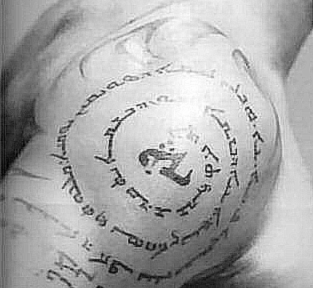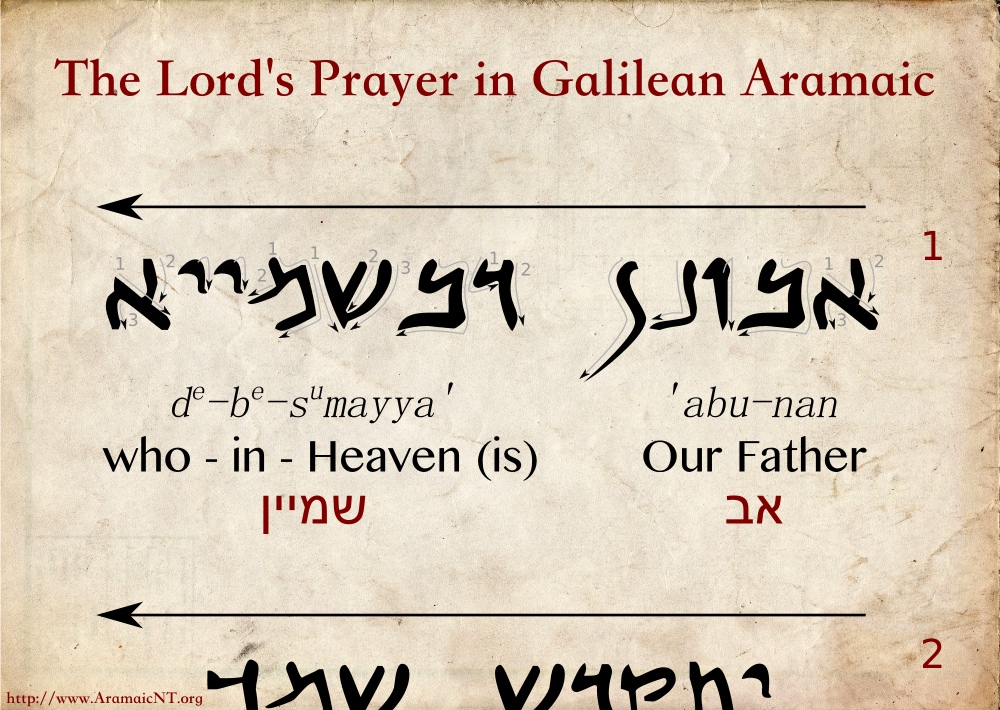UPDATE: Since the publishing of this article, Aramaic Designs now offers a Spiral Lord’s Prayer Tattoo Kit. 🙂
Well, it just goes to show you that when you take your time and look over something carefully that you do a better job at spotting things that are out of place. Thus is my plight with Ricky Martin.
Just the other day, a potential client asked if Aramaic Designs could completely replicate Mr. Martin’s Aramaic tattoo of the Lord’s Prayer. I furnished a quote and sent it over for approval, but in the meantime I went to work to research this particular design to see what it was all about (as preemptive research is one of my favorite hobbies). I, like many people, have seen pictures of it before, and whenever I gave it a cursory look over it seemed very well done and I could easily read snippets of the prayer around the spiral.
 I’ve enhanced the above image to make it more readable.
I’ve enhanced the above image to make it more readable.
Also this image, as a subject of criticism, is being used under the doctrine of Fair Use.Then I tried to read over all of it from start to finish… Which is where things started to get weird.
This is what I was able to read from the above image after I enhanced it, starting at the bottom left and winding all the way to the “Yah” ligature in the center:
‘aykanâ‘ d’âf hnan (this portion I could not make out) : hav lan lahma’ dsuwnqânân yaumanâ‘ : malkuwthâkh nehwâ‘ çevyânâkh ‘aykanâ‘ dvashmayâ‘ : ‘abwun dvashmayâ‘ nethqadash shmakh te’the‘
This translates into the following and I kid you not:
Also as we (the same portion I could not make out) : Give us bread of our need today : Your kingdom may your will be done like which is in heaven : Our father who is in heaven may your name be holy she will come.
Although the individual chunks of text came verbatim from the Syriac Peshitta, they are completely out of order and using a bit of forensics (“source criticism” if you will 😉 ), I can immediately see what caused this tragedy: Whoever arranged this tattoo did not take into account that Aramaic is read from right to left.
Argh!!
Allow me to illustrate exactly what happened. Let us say that our tattoo designer came across the following text in this format:
Our Father who art in heaven hallowed by thy name thy kingdomcome thy will be done on earthas it is in heaven give us this day our daily breadand forgive us our trespasses …
They then took each line of text and connected them in the wrong direction, resulting in:
And forgive us our trespasses as it is in heaven give us this day our daily bread come thy will be done on earth our Father who art in heaven hallowed by thy name thy kingdom
The bigger tragedy is that this could have been
completely avoided.
Several notes to go over:
- The symbol in the center is a Yod-He ligature (“Yah“) which in the Syriac tradition is a shortened form of the Tetragrammaton that symbolizes the Trinity (hence the three dots on top, one on the bottom).
- The reason the spiral trails off in “she will come” is because the Aramaic word te’the‘ (i.e. the “she will come” in question) is referring to “your kingdom” or malkuwthâkh whose grammatical gender is feminine. If it were not obvious what the subject of the clause was, due to ambiguities in Syriac grammar, te’the‘ could also translate as “you (masc.) will come.”
- This only proves once more that if you are going to get a translation done, please trust a professional for both layout and the actual translation, itself. I’ve already done a few posts here (1 2) on The Aramaic Blog about mistaken tattoos, and if you don’t believe me, there are other websites that have examples as well. In fact, don’t just trust a professional, once you’ve obtained a translation have it double-checked with another professional source for accuracy before you even think about permanently affixing it on your skin. (For example Aramaic Designs will double-check translations pro bono.) Laser removal procedures are extremely unpleasant.
=============================
UPDATE November 2012:
For those of you who are interested in how The Lord’s Prayer looked like and sounded like back in Jesus’ time, I have posted my reconstruction of The Lord’s Prayer here:
=============================




